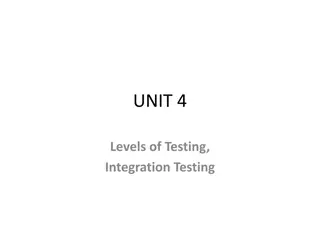
Effective Software Development Tools and Testing Techniques for Java Projects
Explore the world of Java development with Ant, Testing, and JUnit through detailed slides and insightful information on writing test cases, setUp(), and tearDown() methods. Learn how to run test cases effectively and prevent interference between different tests.
Download Presentation

Please find below an Image/Link to download the presentation.
The content on the website is provided AS IS for your information and personal use only. It may not be sold, licensed, or shared on other websites without obtaining consent from the author. If you encounter any issues during the download, it is possible that the publisher has removed the file from their server.
You are allowed to download the files provided on this website for personal or commercial use, subject to the condition that they are used lawfully. All files are the property of their respective owners.
The content on the website is provided AS IS for your information and personal use only. It may not be sold, licensed, or shared on other websites without obtaining consent from the author.
E N D
Presentation Transcript
Software Development Tools COMP220 Seb Coope Ant, Testing and JUnit (2) These slides are mainly based on Java Development with Ant - E. Hatcher & S.Loughran. Manning Publications, 2003 and JUnit in Action , 2nd edition P. Tahchiev, F. Leme, V. Massol, G. Gregory, Manning Publications, 2011
More on writing a test case Recall that a test case is a class which imports some JUnit packages import org.junit.Test; import static org.junit.Assert.*; ... and implements one or more no-argument void@TestmethodstestXXX() (See 11. Ant, Testing and JUnit, JUnit Primer, Slides 5, 6.) where each testXXX()consists of several assertion methods typically comparing expectedandactualvalues. 11. Ant, Testing and JUnit 3
More on writing a test case: setUp() and tearDown() Additionally, to prevent one @Test method from affecting the behaviour of another we can a. annotate by @Before and implement a method public void setUp() which - initializes objects under test - by storing a state (fixture) as member variables to the test case b. public void tearDown() which - releases objects/resources under test. c. For this to work, we also need to import from Junit: import org.junit.Before; import org.junit.After; Optionally, annotate by @After and implement a method The namessetUp and tearDownare traditionalafter JUnit3. JUnit4 annotations@Beforeand@After make the behaviour of setUp and tearDown as required. (See also next slides.) 4
Running a test case with setUp() and tearDown() Test Runnercalls the same setUp() and tearDown() methods before and aftereach@Test method testXXX() is invoked. Thus, each @Test method testXXX() runs under one and the same fixture created by setUp()(despite this fixture could probably be changed by other test methods testYYY()), hence, with no assumptions about the order in which test methods are called. This prevents one test from affecting the behaviour of another. The following example illustrates this behaviour by using System.out.println("some message"). 5
Test Case setUpTearDownTest.java : package org.example.antbook.junit; //import JUnit4 classes: import static org.junit.Assert.*; import org.junit.Test; // import org.junit.Before; //import org.junit.* also would work import org.junit.After; // Put this file under ch04\test according to the package declaration. Use your personalised package name! Here setUp() and tearDown() methods do nothing besides informing that what they intend to do. public class setUpTearDownTest{ @Before //Runs before each @Test method public void setUp(){ System.out.println("setUp sets up a fixture"); } @After //Runs after each @Test method public void tearDown(){ System.out.println("tearDown releases fixture"); } @Test public void testA(){ System.out.println("testA runs"); assertTrue("MULTIPLICATION FAILED!!!", 4 == (2 * 2)); } @Test //Each method annotated by @Test runs public void testB(){ System.out.println("testB runs"); assertSame("ADDITION FAILED!!!", 4, 2 + 2); } public void SomeTestC(){ System.out.println("SomeTestC runs"); assertSame("ADDITION FAILED!!!", 5, 2 + 2); } } @Test methods Should it fail/run ??? 6
Compile and Run: C:\Antbook\ch04>javac -d build\test test\org\example\antbook\junit\setUpTearDownTest.java Do not forget to recompile each time!!! C:\Antbook\ch04>java -cp build\test;C:\JAVA\junit4.8.2\junit-4.8.2.jar org.junit.runner.JUnitCore org.example.antbook.junit.setUpTearDownTest JUnit version 4.8.2 .setUp sets up a fixture testA runs tearDown releases fixture .setUp sets up a fixture testB runs tearDown releases fixture setUp and tearDown surroundeach @Test annotated method. Time: 0.016 OK (2 tests) Note that someTestC was not run, unlike testA and testB! WHY?? Because only@Test annotated methods should be run by Junit4 test runners. testA() and testB(), succeeded, so, setUpTearDownTestsucceeded too (OK). Replace4 by 5 in testA() and recompile and run it again. What will be changed?WillsetUpTearDownTest succeed? 7
Compile and Run: Do not forget to recompile each time!!! C:\Antbook\ch04>java -cp build\test;C:\JAVA\junit4.8.2\junit-4.8.2.jar org.junit.runner.JUnitCore org.example.antbook.junit.setUpTearDownTest JUnit version 4.8.2 .setUp sets up a fixture testA runs tearDown releases fixture E.setUp sets up a fixture testB runs tearDown releases fixture E means that the previoustestA failed Time: 0.015 There was 1 failure: 1) testA(org.example.antbook.junit.setUpTearDownTest) java.lang.AssertionError: MULTIPLICATION FAILED!!! <many lines skipped> FAILURES!!! Tests run: 2, Failures: 1 Your message to yourself Add@Test annotation before someTestC, and compile and run it again. What will be the result? Finally, compile and run this by Ant frommybuild.xml like in Part 11, Slide 14. 8
Writing a Test Suite What if we need to run many JUnit test cases? JUnit, test classes can be grouped into a suite Just use appropriate JUnit imports and annotations @SuiteClasses and @RunWith(value=Suite.class). Grouping tests lets you build several individual test cases for a particular subsystem , and write an all-inclusive Test Suite that runs them all . See AllTests.java below. Note that Suite ofSuites can also be created in the same way. 9
An example of a Test Suite C:\Antbook\ch04\test\org\example\antbook\AllTests.java package org.example.antbook; import org.junit.runner.RunWith; import org.junit.runners.Suite; import org.junit.runners.Suite.SuiteClasses; @RunWith(value=Suite.class) @SuiteClasses(value= {org.example.antbook.junit.SimpleTest.class, org.example.antbook.junit.setUpTearDownTest.class, org.eclipseguide.persistence.FilePersistenceServicesTest.class } ) publicclassAllTests{} End of file Test Suite to run test methods of three test cases: SimpleTest, setUpTearDownTest and FilePersistenceServicesTest. We can also composesuites of suites in the same way. EXTENDtargetjunit-TestRunner in mybuild.xml to RUN test suite AllTests.java. 10
Test Suites and Ant?? Don t need to bother with test suites when running JUnit tests using Ant: Ant itself can list a group of TestCase classes in a much more powerful way all test cases from a directory(!), and run it as a batch from the build file itself. But <java> task is not appropriate for this purpose. 11
The JUnit task <junit>
The JUnit task <junit> The Ant's task <junit> is much better for running JUnit test cases than <java> which we used till this point: <junit> runs one or more (even all from a directory) JUnit test cases Collects and displays test results in one or more formats Provides a way either to fail or continue a build when a test fails Recall the unnatural situation when BUILD SCCESSFUL while some tests failed. No need to mention explicitly any Test Runner(as it was necessary with <java> task) 13
The JUnit task <junit> (cont.) In order to execute some existing test cases by Ant, let us declare a special <junit> task with the names of the test cases and appropriate classpath : <target name="test-brief" depends="test-compile"> <classpath> with id test.classpath formerly used for running test cases by <java> and some <javac> tasks <junit> <classpath refid="test.classpath"/> <test name = "org.eclipseguide.persistence.FilePersistenceServicesTest"/> <test name="org.example.antbook.junit.SimpleTest"/> One or more test cases to run </junit> </target> Extendmybuild.xml by this target. You can also add: <test name="org.example.antbook.junit.setUpTearDownTest"/> 14
The JUnit task <junit> (cont.) TRY it: H:\Antbook\ch04>ant -f mybuild.xml test-brief Buildfile: C:\Antbook\ch04\mybuild.xml [SOME MESSAGES OMITTED] test-brief: [junit] Test org.eclipseguide.persistence. FilePersistenceServicesTest FAILED BUILDSUCCESSFUL <junit>TESTFAILED, butBUILD SUCCESSFUL (?!) It would be more natural to see here also BUILDFAILED... But let us wait for a more advanced build with <junit>. Nothing above about org.example.antbook.junit.SimpleTest because it does not fail. TRY to confirm this by appropriate experiment. 15
The JUnit task <junit> (cont.) Testfailure enforcing buildfailure There are two issues to note about these results: 1. no details were provided about whichtestXXX() method in FilePersistenceServicesTest failed and why, not so bad no cluttering messages, But, on the other hand, insufficiently informative 2. the build completed successfully (?!) despite the test failure looks not natural. However, ADD to the task <junit> two attributes: <junit haltonfailure="false" printsummary="true"> We now get more informative and coherent output: (a default value) 16
The JUnit task <junit> (cont.) Testfailures enforcing buildfailures Now it is more informative: test-brief: [junit]Running org.eclipseguide.persistence.FilePersistenceServicesTest [junit]Tests run: 5, Failures: 2, Errors: 0, Time elapsed: 0.031 sec [junit] Test org.eclipseguide.persistence.FilePersistenceServicesTest FAILED [junit]Running org.example.antbook.junit.SimpleTest [junit] Tests run: 1, Failures: 0, Errors: 0, Time elapsed: 0.016 sec BUILD SUCCESSFUL Total time: 1 second printsummary="true" prints one-line statistics for each test case. Takinghaltonfailure="true" gives results only up to the first failure: test-brief: [junit]Running org.eclipseguide.persistence.FilePersistenceServicesTest [junit] Tests run: 5, Failures: 2, Errors: 0, Time elapsed: 0.031 sec BUILD FAILED C:\Antbook\ch04\mybuild.xml:140: Test org.eclipseguide.persistence.FilePersistenceServicesTest failed NowBUILD FAILED because of first failing test case(!!) 17
Structure directories to accommodate testing See also Part 11, slide 13 Recall and extend the directory structure in ch04: C:\Antbook\ch04- base directory (basedir= ".") C:\Antbook\ch04\src- source directory (${src.dir}) C:\Antbook\ch04\test- test directory (${src.test.dir}) containing (deeper) JUnit test classes C:\Antbook\ch04\build- build directory (${build.dir}) C:\Antbook\ch04\build\classes - for compiled source files (${build.classes.dir}) C:\Antbook\ch04\build\test - for compiled JUnit test cases (${build.test.dir} ) C:\Antbook\ch04\build\data - for test repots in XML format C:\Antbook\ch04\build\report - for test repots in HTML format (new directories data and reportto be considered later) First 3 red coloured directories and their contents are created by yourself. 18 Other directories should be created automatically by your Antbuild file.
Four main steps to do inAntbuild file related to JUnittesting Adding testing into our build process is straightforward: Add a few targets or tasks: 1. target test-init to initialize (<mkdir>) the testing directory structure (except directories created by yourself manually; these are last three directories on the previous slide), 2. target test-compile to compile the test code with <javac>, 3. target test (or the like) to execute the tests with <junit> (or <java>), 4.<junitreport> and <report> tasks to generate the test reports (to be considered later). Note that besides testing we need as usually also steps and targetsdealing with source code in src not mentioned above. 19
Ant build process related to JUnit testing Some more details Before above four steps, we should start with assigning properties to various directories used by our (compile and) test targets: <property name="src.dir" value="src"/> C:\Antbook\ch04\src <property name="src.test.dir" value="test"/> C:\Antbook\ch04\test <property name="build.dir" location="build"/> More properties... C:\Antbook\ch04\build Benefits of presentation of directories by properties: If you want to change your system of directories, this can be done only in one place of build file. 20
Ant build process related to JUnit testing Some more details Benefits of presentation of directories by properties: Also, we can easily control e.g. where Ant places test reports by overriding test.reports.dir in command line as -Dtest.reports.dir=C:\REPORTS to temporarychange the standard (default) behaviour described in our Ant build file. Thus, in mybuild.xml you should present all directories by properties (except those directories related to package declarations which you create manually for your source files and test cases and need not mention in mybuild.xml)! 21
Ant build process related to JUnit testing Some more details For compiling and running source files and tests cases we need classpath which has been already introduced into mybuild.xml in 11. Ant, Testing and JUnit, Slides 14 and 29 (and repeated now): <pathid="test.classpath"> <pathelement location="${build.test.dir}"/> <!-- build/test --> <pathelement location="C:\JAVA\junit4.8.2\junit-4.8.2.jar"/> <pathelement location="${build.classes.dir}"/> <!-- build/classes --> </path> CHECK all targets, tasks, properties and paths inmybuild.xml required for running test-brief target (and for other future test targets). 22
Ant build process related to JUnit testing Some more details In mybuild.xml, testing can possibly be preceded by a <copy> task C:\Antbook\ch04\build\test <copy todir="${build.test.dir}"> <fileset dir="${src.test.dir}" excludes="**/*.java,**/*.class"/> </copy> C:\Antbook\ch04\test This brings over all non-.java resources: For example, assume that an html file is required as an argument of a Java program which should do something with this file (read it, parse it, search some information in it, etc). Then we need an example of such file test.html somewhere under C:\Antbook\ch04\test , and so test.html, should be copied into the ${build.test.dir}, to allow our compiled JUnit test cases to access test data file test.html easily . 23






















